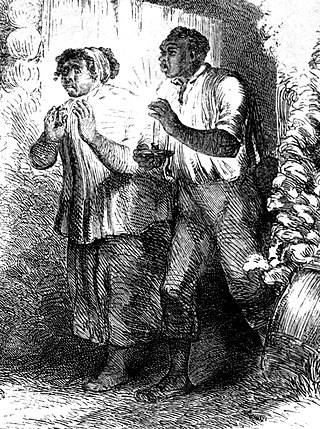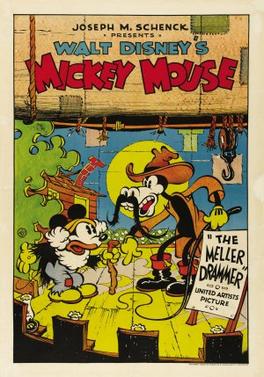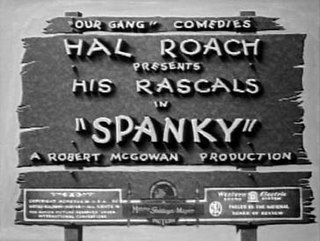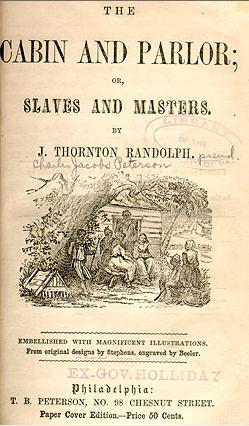Evolution of Uncle Tom's Cabin in film
Edwin S. Porter's 1903 film production, Uncle Tom’s Cabin; or, Slavery Days, was based largely off of the theatrical productions of the same story common during that time. The movie lived up to racial stereotypes in wide circulation, and scenes were included to showcase slave dances. While African-American extras made appearances, white actors in blackface played the main slave characters. The film storyline strays widely from the plot of the novel, as exemplified by a scene completely independent of the novel depicting a steamboat race. The film assumes the audience is generally familiar with the plot due to the story's long running popularity. [2]
Universal Studio's 1927 release of Uncle Tom’s Cabin was an epic film and a step forward for Stowe's work. While certain stigmatic similarities remained, such as scenes depicting outlandish slave dances and Topsy's flamboyant unruliness, this version was less outmoded in its characterization of slaves. More than earlier adaptations, this film took care to accurately follow the book, and some lines in the movie are direct quotes from the text. Integral characters omitted from previous films were brought to the forefront, such as George Harris. While the overall story remained intact, the writers did take some liberties. For instance, after escaping to freedom, Eliza and Harry are captured by the lawyer Marks and runaway slave tracker Tom Loker and sold down the river as opposed to receiving aid from kindly Quakers. Harry is separated from his mother when purchased by a nameless slave-owner before eventually being reunited with his father. Eliza is sold off to Simon Legree at the same auction as Uncle Tom. This alteration omits the entire subplot involving the Harris family's escape to Canada, weaving the story into one coherent plot. Another twist in the storyline occurs when Union soldiers on the march through the south liberate hundreds of slaves along the way, including the residents of Legree's plantation. The director moved the story forward historically to capitalize on the public's patriotic sympathies.
Socially, this film was more progressive than previous versions. Fewer characters were portrayed in blackface (Topsy is an outstanding exception) and less of an emphasis was put on exotic slave customs. Still, the majority of the screen time is dedicated to the white actors. African American actor James B. Lowe played the character Uncle Tom, but was on screen for less than 9 minutes and speaks less than a dozen lines. [12]

Uncle Tom is the title character of Harriet Beecher Stowe's 1852 novel Uncle Tom's Cabin. The character was seen by many readers as a ground-breaking humanistic portrayal of a slave, one who uses nonresistance and gives his life to protect others who have escaped from slavery. However, the character also came to be seen as inexplicably kind to white slaveholders, especially based on his portrayal in pro-compassion dramatizations. This led to the use of Uncle Tom – sometimes shortened to just a Tom – as a derogatory epithet for an exceedingly subservient person or house negro, particularly one aware of his or her own lower-class racial status.

Uncle Tom's Cabin; or, Life Among the Lowly is an anti-slavery novel by American author Harriet Beecher Stowe. Published in two volumes in 1852, the novel had a profound effect on attitudes toward African Americans and slavery in the U.S., and is said to have "helped lay the groundwork for the [American] Civil War".

The Leopard's Spots: A Romance of the White Man's Burden—1865–1900 is the first novel of Thomas Dixon's Reconstruction trilogy, and was followed by The Clansman: A Historical Romance of the Ku Klux Klan (1905), and The Traitor: A Story of the Fall of the Invisible Empire (1907). In the novel, published in 1902, Dixon offers an account of Reconstruction in which he portrays a Reconstruction leader, Northern carpetbaggers, and emancipated slaves as the villains; Ku Klux Klan members are anti-heroes. While the playbills and program for The Birth of a Nation claimed The Leopard's Spots as a source in addition to The Clansman, recent scholars do not accept this.
Uncle Tom's Bungalow is an American Merrie Melodies animated cartoon directed by Tex Avery, and released to theatres on June 5, 1937, by Warner Bros. The short cartoon is a parody of the 1852 novel Uncle Tom's Cabin and of the "plantation melodrama" genre of the 1930s. It contains many stereotypical portrayals of black characters. The cartoon plays off Harriet Beecher Stowe's novel in that it portrays Uncle Tom as an old man, and wooden shacks and cotton fields pervade the scenery. Director Tex Avery adds his own sense of humor and "trickster" animation, giving the classic theme a modern, humorous twist.

Mickey's Mellerdrammer is a 1933 American animated short film produced by Walt Disney Productions and released by United Artists. The title is a corruption of "melodrama", thought to harken back to the earliest minstrel shows, as a film short based on Harriet Beecher Stowe's 1852 anti-slavery novel Uncle Tom's Cabin and stars Mickey Mouse and his friends who stage their own production of the novel. It was the 54th Mickey Mouse short film, and the fourth of that year.

Margarita Fisher was an American actress in silent motion pictures and stage productions. Newspapers sometimes referred to her as "Babe" Fischer.

A Escrava Isaura is a novel written by the Brazilian writer Bernardo Guimarães. It was first published in 1875 by Casa Garnier publishers in Rio de Janeiro. With this novel, Bernardo Guimarães became very famous throughout that country, even said to be admired by Brazil's last Emperor Dom Pedro II.

Tom show is a general term for any play or musical based on the 1852 novel Uncle Tom's Cabin by Harriet Beecher Stowe. The novel attempts to depict the harsh reality of slavery. Due to the weak copyright laws at the time, a number of unauthorized plays based on the novel were staged for decades, many of them mocking the novel's strong characters and social message, and leading to the pejorative term "Uncle Tom".

Spanky is a 1932 Our Gang short comedy film directed by Robert F. McGowan. It was the 113th Our Gang short that was released. The film was based on Our Gang co-star George "Spanky" McFarland.

Little Eva: The Flower of the South is an Anti-Tom children's book by American writer Philip J. Cozans. Although its publication date is unknown, scholars estimated the release was either in the 1850s or early 1860s. The book follows Little Eva, the daughter of a wealthy Alabama planter. She is characterized through her kindness toward slaves as she reads the Bible to them and teaches the alphabet to slave children. On her ninth birthday, Little Eva nearly drowns, but is rescued by a slave named Sam. Her parents free Sam who decides to remain with the family because he loves them.

The Cabin and Parlor; or, Slaves and Masters is an 1852 novel by Charles Jacobs Peterson, writing under the pseudonym J. Thornton Randolph.

Uncle Tom's Cabin is a 1927 American silent drama film directed by Harry A. Pollard and released by Universal Pictures. The film is based on the 1852 novel Uncle Tom's Cabin by Harriet Beecher Stowe and was the last silent version filmed.

Uncle Tom's Cabin was a 1918 American silent drama film directed by J. Searle Dawley, produced by Famous Players–Lasky Corporation and distributed by Paramount Pictures under the Famous Players–Lasky name. The film is based on Harriet Beecher Stowe's 1852 novel Uncle Tom's Cabin and George Aiken's eponymous play.

Uncle Tom's Cabin is a 1914 American silent historical drama film directed by William Robert Daly using Vitagraph and starring Sam Lucas, Walter Hitchcock, and Hattie Delaro. It was based upon playwright George L. Aiken's theatrical adaptation of Harriet Beecher Stowe's 1852 novel Uncle Tom's Cabin. It was produced at Fort Lee, New Jersey by the newly founded World Film studio.

Topsy and Eva is a 1927 American drama silent film directed by Del Lord and written by Catherine Chisholm Cushing, Scott Darling, Dudley Early and Lois Weber. D. W. Griffith also directed additional scenes. It is based on the two key female figures in Harriet Beecher Stowe's 1852 classic novel Uncle Tom's Cabin.

Uncle Tom's Cabin is a 1910 American silent short drama produced by the Thanhouser Company. The film was adapted by from the 1852 novel Uncle Tom's Cabin by Harriet Beecher Stowe. The plot of the Thanhouser production streamlined the actual story to portray the film over the course of a single reel. The film was released on July 26, 1910, on the same day that Vitagraph released the first reel of their own three reel version of Uncle Tom's Cabin. This prompted the Thanhouser Company to advertise against the Vitagraph film by referring to the other as being overly drawn out. The film garnered mixed, but mostly positive reception in trade publications. The film is presumed lost.

Uncle Tom's Cabaña is a 1947 American animated short film directed by Tex Avery. The short is a parody of Harriet Beecher Stowe's 1852 novel Uncle Tom's Cabin, and is Avery's second parody of the novel, the first being Uncle Tom's Bungalow in 1937 while at Warner Bros. Cartoons.
Uncle Tom's Cabin is a 1987 American made-for-television drama film directed by Stan Lathan and starring Avery Brooks, Bruce Dern, Phylicia Rashad, and Edward Woodward. It is based on the 1852 novel of the same name by Harriet Beecher Stowe.

Uncle Tom's Cabin is a 1903 American silent short drama directed by Edwin S. Porter and produced by the Edison Manufacturing Company. The film was adapted by the 1852 novel Uncle Tom's Cabin by Harriet Beecher Stowe. The plot streamlined the actual story to portray the film over the course of 19 minutes. The film was released on 3 August 1903 at the Huber's Fourteenth Street Museum in New-York.
Meredith Calhoun was a planter and slaveholder, merchant, and journalist, known for owning some of the largest plantations in the Red River area north of Alexandria, Louisiana. His workers were enslaved African Americans. Calhoun played a major role in the inter-regional slave trade of the American South, acting as a broker for the purchase and sale of thousands of enslaved persons.


















